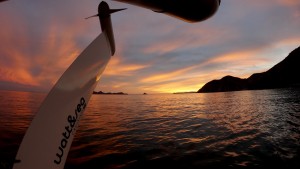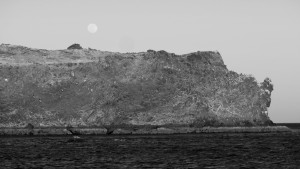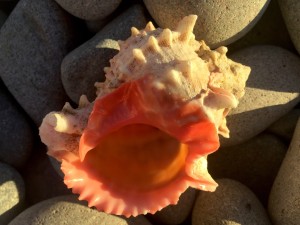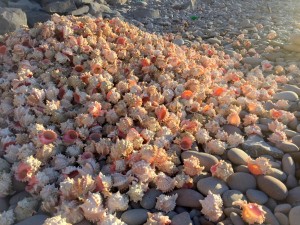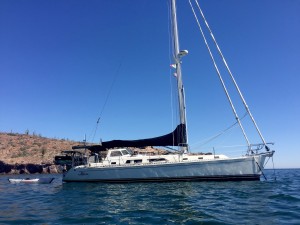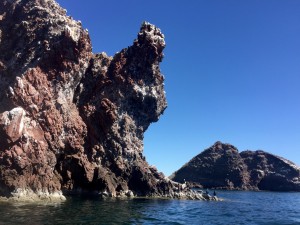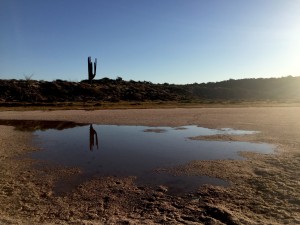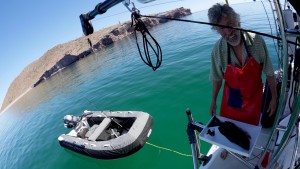It may be that it took us until then end of February to have our first real glimpse of the kind of days we expected this to be. Where we did not feel pinned down by a norther, or compelled by a schedule. We sailed where to the wind blew. Upwind actually, but we followed the course Allora was happy to take, without tacking and found a place that had what both of us were looking for. A breakthrough mosaic project, and fishing.
For the first few days we were here a small panga with fishermen visited and fished hard at the points of rocks on either side of the small cove where we anchored. I studied them with binoculars trying to decide what techniques they were using. Two younger guys with hand lines, and the owner of the boat with a spinning rod. The anchored and the handliners went to work. I did not see them catch more than one small fish, and wondered if they were catching bait. But it really looked like the spin fisherman was using a lure and jigging. I saw his rod bend a few times, but the fish seemed to get away. Then they moved to the other point and fished until almost dark. The next morning I went to the point where they were with my 11 weight (because the other rods are still buried under the aft bunk), and my spinning outfit with a white bucktail jig with rubber bait. There was very little breeze so I drifted and cast to the rocks, getting one strike almost right away, but the fish shook the hook in a few minutes. I decided my drag was too light for setting the hook and cranked it down a bit. It didn’t take much longer, maybe twenty minutes and I hooked a fish that pulled with conviction. The spin outfit bent over double as whatever it was ran deep for the rocks. Definitely a lot of fun, but I really wanted to know what it was so I didn’t want to lose it. I finally got the fish to the surface, some kind of grouper I thought, about four pounds. I tried killing it with a dash of tequila on the gills (heard talk of this working), but that only seemed to invigorate him and he made a mad dash from my hands back into the water. I resorted to more caveman-like tactics to subdue him. The fishermen were moving from their morning spot over to where I was fishing, so I decided to motor over and intercept them. I wasn’t sure how they’d feel about my fishing in their spot, or if they might be unhappy that I’d taken a nice fish. They were smiling as I pulled up and apologized for not speaking Spanish, so I hauled the fish up where they could see it. They seemed impressed and smiled. I asked, “Come se dice?” which was intelligible enough for them to inform me that it was a Cabrilla. The owner of the boat then lifted his own, the same size or a little bigger, which he’d also caught at the point. He asked to see what I was using and showed me his lure, too. I then did my best with sign language to confirm that it was okay to eat the Cabrilla. Not only okay, but very good was the answer. Bueno? I asked. Buena, they corrected. And it was, maybe one of the best filets of fish I’ve ever had. Super yummy.
My next trip out I decided to stick to fly fishing to see what might happen. I tied on the smallest Deceiver I had in the fly box and cast it out as far as I could, stripping it back the way I would on a river for trout, maybe a little faster. The fly would arrive with a bunch of interested fish, darting at it but not really hitting it. I tried a little faster, or maybe not, maybe I was just lucky but I hooked one. It fought hard, harder than any trout, but was seriously outmatched by the 11 wt. I let the line go slack, and the fish got off, though I’d gotten a pretty good look at it. A few minutes later I landed one, and had a heck of a time getting the hook out, destroying the fly in the process. I bent the barb down on the next fly, but didn’t get any more strikes after that. I looked the fish up when I got back to the boat and decided it was a Triggerfish, which my mother says is one of her favorites. The Mexican fishermen weren’t around to ask if it was okay to eat and since it’s a reef fish, we’ll wait until we can get a confirmation. We don’t want a case of ciguatera.
Finally, I went out to the point of rocks. I’d tried it once before but was really intimidated by the current and waves. I tried anchoring but couldn’t even reach bottom with Namo’s little anchor. This time it was a little calmer. Right away I brought in a school of long slender fish that were very aggressive with the fly, slashing at it and attacking; one even came out of the water after it, but none of them were getting hooked. I checked my leader and it was a little chewed up. This time I thought I knew what kind of fish it must be, a Sierra Mackerel, which I’d heard about. A few more casts, a few more strikes and then WHAM! This fish bent the rod and ripped line out of my hand. For me the first real fish here on a fly. It was a great battle and a gorgeous fish. It’s mouth was full of teeth so I was really glad to have bent the barb down and to have a pair of pliers, so I could release the fish without touching it.
I fly fished some more without luck, then switched to the spin outfit and caught a small Cabrilla. I had to drag it with me to row Namo away from some rocks and then I let it go. I decided, just for the heck of it to make a few more fly casts as I drifted out along the shelf of this outer rock. I’d made my last cast when suddenly a really big fish showed up behind the fly – at least thirty pounds and given where it was it must have been a yellowtail tuna. I stripped the fly faster but it wasn’t fast enough… but exciting because it was so unexpected. I tried a little more, including with the spin rod, but no luck. Diana would have loved sushi for dinner. Maybe next time.

